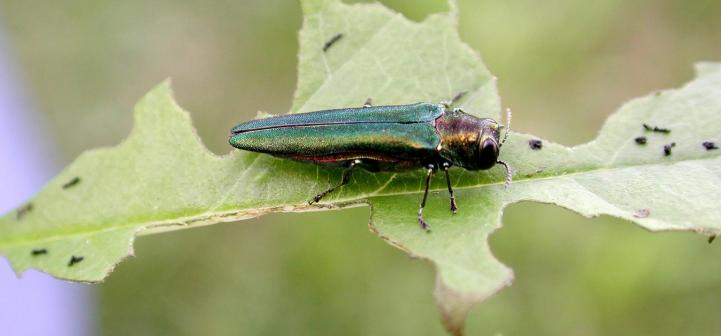Invasive Species: Arthraxon hispidus, Small Carpgrass
Small carpgrass is an invasive annual grass that was introduced into the United States, either accidentally or by immigrants, from Japan and eastern Asia. The plant stands to 1.5 ft. (0.5 m) tall with oval to lance-shaped leaves. Leaves are 1-3 in. (2.5-7.6 cm) long, 1/5 in. (0.5 cm) wide and have heart-shaped bases. The margins of the leaves have conspicuous hairs. Flowers bloom in early fall and are contained in 1 to several, 1-3 in. (2.5-7.6 cm) long spikes. The seeds are slender and yellowish in color, measuring 0.2 inches (4 mm) long. Small carpgrass inhabits wet areas such as stream banks, flood plains, and shorelines.
What are invasive species and why should we be concerned about them?
Taxonomy: Scientific and Common Names for This Species
Cyperales > Poaceae > Arthraxon hispidus (Thunb.) Makino
Synonym(s): jointhead arthraxon, hairy jointgrass
Arthraxon hispidus – USDA PLANTS Profile
Distribution Maps
Small carpgrass – The reported distribution of this invasive species across the United States (Source: Invasive Plant Atlas of the United States)
Up-to-the-minute distribution maps and why they are important
Reporting This Invasive Species
What is the best way and place to report the occurrence of an invasive species?
How to report an invasive species sighting to EDDMapS – Early Detection & Distribution Mapping System
EDDMapS – Report an invasive species to EDDMapS.
Cooperative Extension Offices – Find your local Cooperative Extension office on this map provided by USDA.
How to Identify
This invasive species can be identified by looking for the characteristics described in the paragraphs that follow.
Grass
It is an annual that stands to 1.5 ft. (0.5 m) tall with oval to lance-shaped leaves.
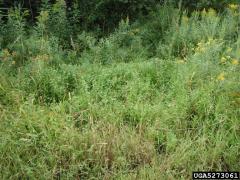 |
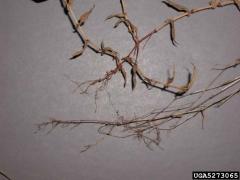 |
| Leslie J. Mehrhoff, University of Connecticut, bugwood.org | Leslie J. Mehrhoff, University of Connecticut, bugwood.org |
Foliage
Leaves are 1-3 in. (2.5-7.6 cm) long, 1/5 in. (0.5 cm) wide and have heart shaped bases. The margins of the leaves have conspicuous hairs.
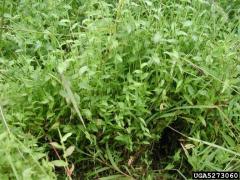 |
 |
| Leslie J. Mehrhoff, University of Connecticut, bugwood.org | Leslie J. Mehrhoff, University of Connecticut, bugwood.org |
Flower
Flowers bloom in early fall and are contained in 1 to several, 1-3 in. (2.5-7.6 cm) long spikes.
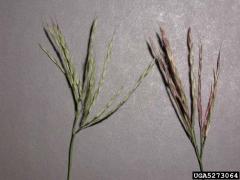 |
 |
| Leslie J. Mehrhoff, University of Connecticut, bugwood.org | Leslie J. Mehrhoff, University of Connecticut, bugwood.org |
Fruit
The seeds are slender and yellowish in color, measuring 0.2 inches (4 mm)long.
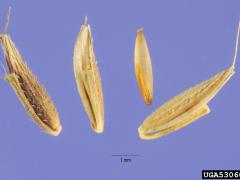 |
|
| Steve Hurst, USDA NRCS PLANTS Databse, bugwood.org | bugwood.org |
Native Species That Can Resemble Small Carpgrass
– Images at invasive.org
| bugwood.org | bugwood.org |
– Images at invasive.org
| bugwood.org | bugwood.org |
Additional Images for Small Carpgrass
Small carpgrass – Images at Invasive.org
Additional Information, Biology, Control and Management Resources
Control and management recommendations vary according to individual circumstances. Location, habitat, weather, and a variety of other conditions are factors that help determine the best treatment choice. To find the safest and most effective treatment for your situation, consult your state’s land-grant institution. If you will use chemicals as part of the control process, always refer to the product label.
United States Land-Grant University System – Find your land-grant university’s college of agriculture, Cooperative Extension office, or other related partner on this map provided by USDA.
Invasive Plant Atlas of New England – University of Connecticut
Weed of the Week – USDA Forest Service
Invasive Plants of Asian Origin Established in the United States and Their Natural Enemies – USDA Forest Service
